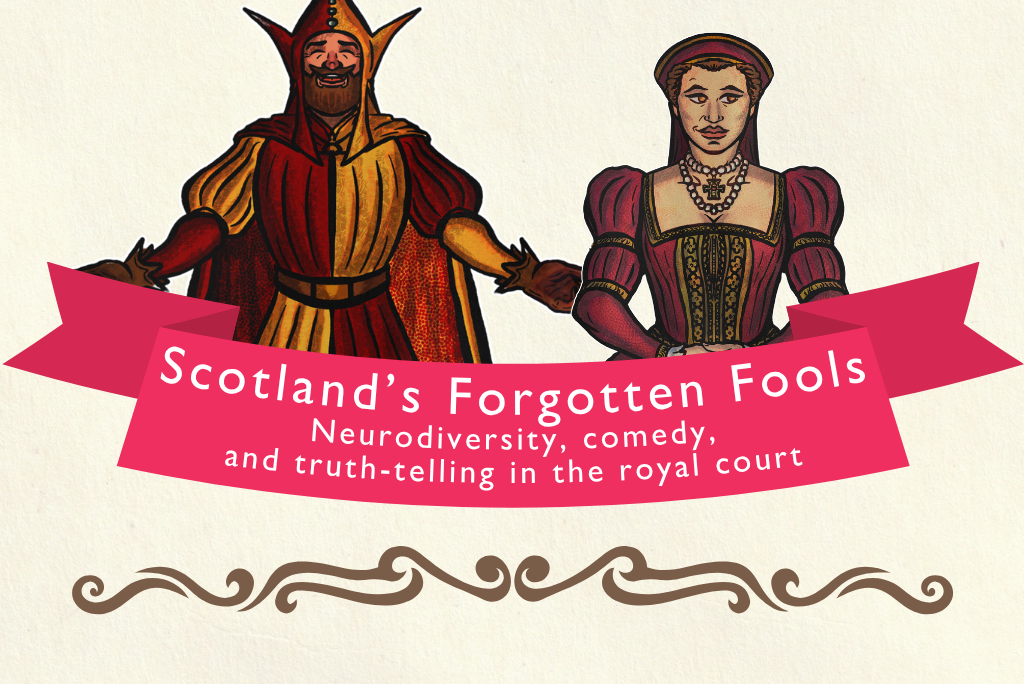Have you ever heard of a court jester? Maybe you picture someone in a colourful outfit juggling or cracking jokes. But what if I told you that in Renaissance Scotland, some of these jesters weren’t just entertainers? They were neurodivergent individuals whose unique minds gave them a special place in history.
This blog explores the fascinating world of natural fools in fifteenth and sixteenth century Scotland. These people with disabilities played powerful roles in royal courts. They weren’t just there to make kings and queens laugh. They were truth-tellers, companions, and symbols of divine wisdom. Their stories deserve to be remembered.
Just a wee word of warning: this blog includes material taken from contemporary sources and some of the descriptions they use are offensive and outdated, so reader discretion is recommended.
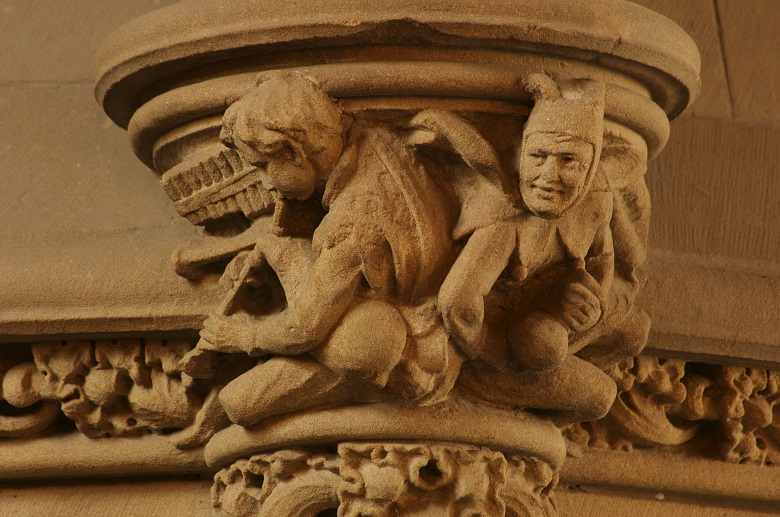
Detail of jester and musician on the corbel of the fireplace in the great hall, Edinburgh Castle.
Natural fools and artificial fools
Not all jesters were the same. In the past, the terms ‘natural fool’ and ‘artificial fool’ were used to distinguish between different types of people involved in entertaining the court.
Natural fools
Today, we use terms like autism or ADHD to describe neurodiversity. Back then, people didn’t have those labels, but they still recognised that some individuals thought and behaved differently. Instead of excluding them, Scottish courts often celebrated their differences.
Natural fools were seen as child-like and therefore closer to God and able to understand divine truths. They weren’t just entertainers; they were companions and truth-tellers. In historic records we see evidence that they were valued rather than mocked.
But this didn’t mean life was perfect. Outside the court, neurodivergent people faced challenges. They were often seen as unable to work, marry, or manage money. Even at court, they were simultaneously included, but still outsiders. They depended on their royal masters and could be punished harshly if they made mistakes.
Artificial fools
In contrast, artificial fools were neurotypical performers, similar to modern neurotypical comedians. They did occasionally perform at the royal court, but they became less popular than natural fools.
A belief arose that neurotypical fools (and entertainers generally) were sinners who could do normal ‘werken, if thei wolde’ but instead chose easy lives entertaining. People thought that artificial fools were essentially stealing jobs from neurodivergent people who could only ‘proffite’ others by letting people laugh and take ‘pleasure’ in them.
As royal courts became wealthier and more complex, they created specialised roles like the court jester for neurodivergent individuals.
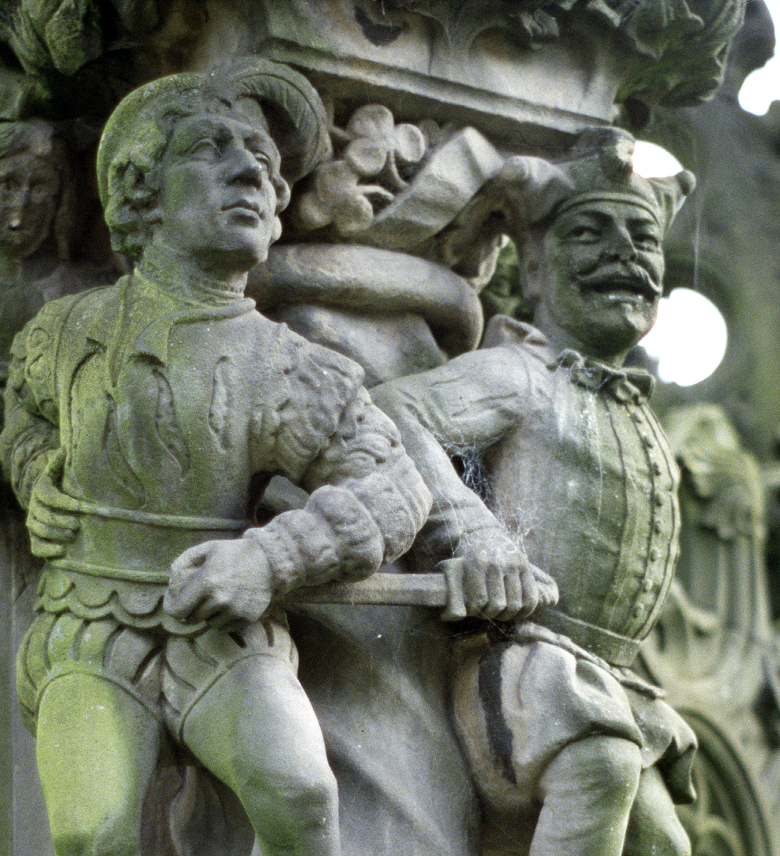
View of detail of Holyrood Palace Fountain, showing George Buchanan (court fool of James VI) stabbing the Duke of Devonshire. Take a closer look on trove.scot
How do we know about Scotland’s historic fools?
Most of what we know about Scottish court fools comes from Treasurer’s Accounts. These are official records that tracked royal spending. The accounts list payments for clothing, travel, and care for fools, showing how closely they were involved in court life. We also learn about them through the poetry of William Dunbar (around 1460-1520), who wrote vivid and sometimes cheeky verses about the court fools.
Sadly, some of Scotland’s royal household records were lost when a ship carrying important documents sank on its way to London in the 1600s. Because of this, many stories and details about these fascinating figures have disappeared forever. What survives gives us only glimpses, but those glimpses are powerful.
Let’s meet some of Scotland’s most intriguing fools.
Curry – the king’s constant companion
Curry was the fool of King James IV, and he was always by the king’s side. Unlike many nobles who only saw the king occasionally, Curry travelled with him across Scotland. He needed a high level of support, and the royal treasurer regularly paid for his travel, accommodation, and even his ‘keeper’. This was someone who looked after him like a carer. According to Dunbar, Curry was so disabled he was incontinent, something which treasurer payments seem to prove.
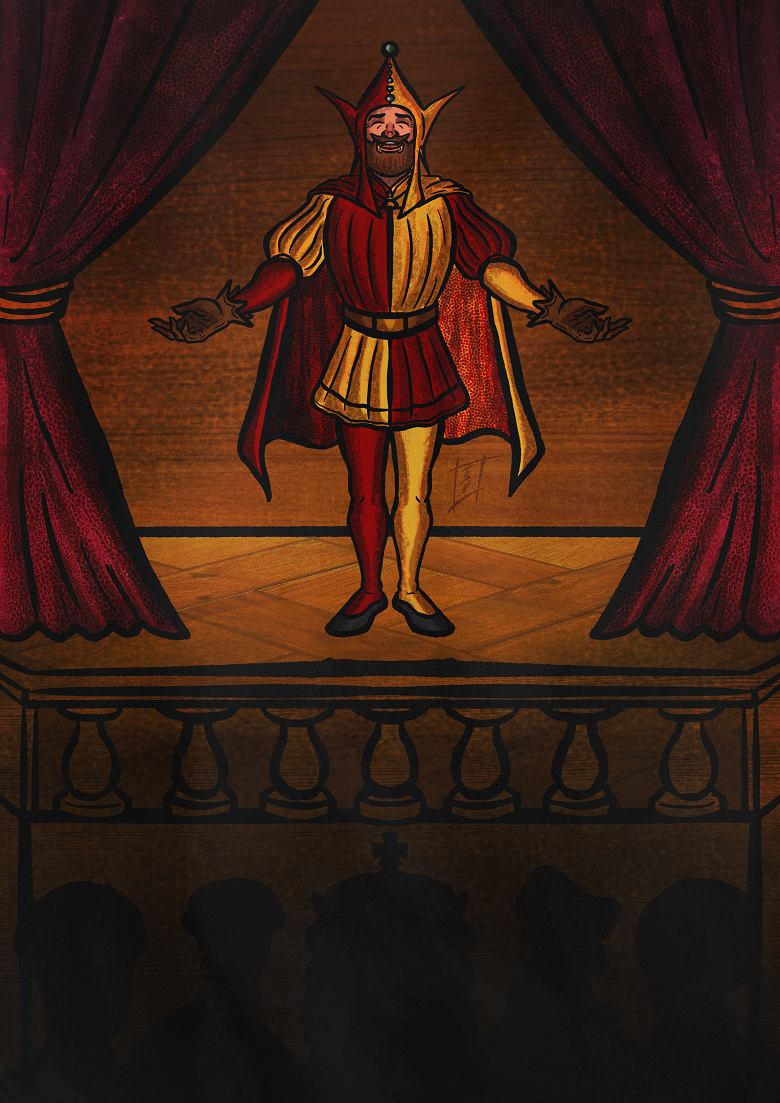
Illustration of Curry by Thomas Secmezsoy-Urquhart
Curry was later married to another natural fool, “Daft Anne”.
Though we don’t have records of Curry’s performances, his presence alone was meaningful. He brought joy, companionship, and reminded the king of his duty to care for the “worthy poor.”
Sir Thomas Nornee – the mock knight
Imagine a knight who dances, fights in tournaments, and mocks the very idea of knighthood. That was Sir Thomas Nornee, another fool at James IV’s court. He was like a real-life version of Ser Dontos from Game of Thrones: a parody of noble ideals.
Nornee could dance, but only Highland dances. He could fight, but preferred boxing and cattle raids over chivalric duels. Dunbar’s poems suggest he was a Highlander commoner, making his mocking of Lowland aristocratic virtues and ideals funnier in contrast, while also mocking a culture in the north which we often fail to realise was deeply cut off from the court and monarch even in the sixteenth century.
In 1508, Nornee took part in a grand tournament in Edinburgh, possibly performing alongside another fool called Cristofer who was noted as teaming up with a child to fight a paper dragon.

Mike the puppeteer at the Making Merry event at Stirling Castle. Image credit: Rob McDougall
John Bute – the dancing satirist
John Bute was a dancing fool who brought satire to the Scottish court. In 1506, he performed in a comedy about doctors. In 1513, he wore a sea-themed costume to dance at the launch of the king’s ship, the Great Michael.
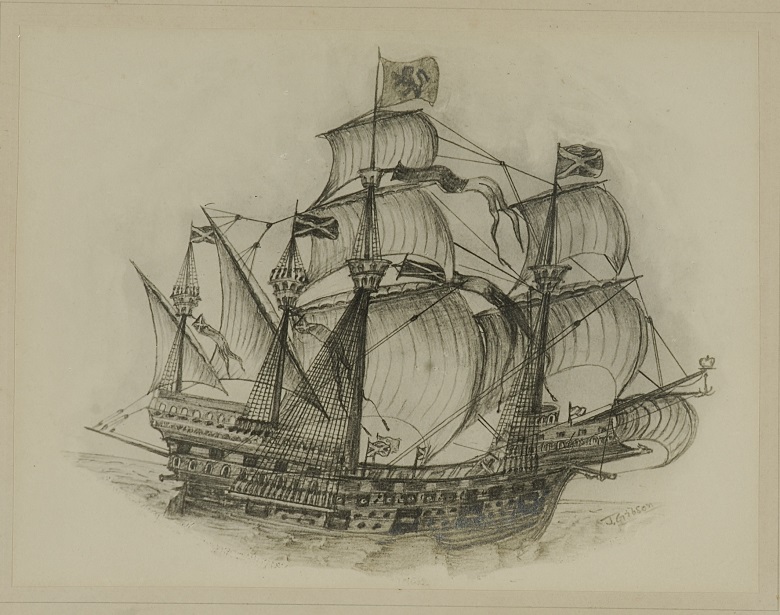
Print of drawing of the ‘Great Michael’ by J Gibson. On display at Trinity House.
One poem by Dunbar tells a wild story where Bute announces that the almoner (a religious official) had an unfortunate accident during a performance. Whether true or not, it shows how fools could poke fun at even the most serious figures.
Than cam in the maister almaser,
An hommiltye-jommeltye juffler.
Lyk a stirk stackarand in the ry,
His hippis gaff mony hoddous cry.
John Bute the fule said, “Wa es me,
He is bedirtin, fye, fy!”
A mirrear dance mycht na man se.
Then came in the master almoner,
An awkward, clumsy person.
Like a cow stumbling in the rye,
His hips gave many hideous cries.
John Bute the fool said, “Woe is me,
He is covered in 💩, fie, fie!”
A merrier dance might no man see.
John Lowis – the fool who told the truth
A natural fool of James V, he often misunderstood court etiquette. Driven to distraction by his supposed rudeness, an angry courtier told him he must bow to his social betters, or he’d be beaten. Lowis, upon asking how he can tell commoners from the nobility and courtiers, was told if someone arrived wearing luxurious clothing and jewels then that was the cue to bow. Later the courtier found the fool bowing to some mules dressed in luxurious cloth and jewels. Poor John was beaten for his actions.
This story, written by William Turner in 1555, shows how fools could expose hypocrisy. His innocent mistake, made by literally following instructions, made a powerful point about how people were judged.
Serat and Nichola La Jardiniere – the queen’s fools
In Scotland, female fools were mostly found in the households of queens. They weren’t just entertainers; they often served as companions and were seen as symbolic figures who represented the disabled poor. While it’s possible they played a comedic role like male fools, there’s no surviving evidence to confirm this, which suggests their roles may have been shaped differently by gender.

Mary Queen of Scots
What we do know fits with broader patterns showing that court jesters and fools gained status during the sixteenth century. These women were treated with respect. They wore luxurious clothes and took part in royal rituals like weddings and Maundy Thursday events.
While male fools often performed comedy, female fools had different roles. Serat and Nichola La Jardiniere served Mary of Guise and Mary Queen of Scots. They came from France and travelled with their queens to Scotland, offering companionship and comfort in a foreign land.
When Mary Queen of Scots was forced to abdicate in 1567, Nichola was left behind in Scotland. Mary fled to England and was imprisoned for 19 years before her execution.
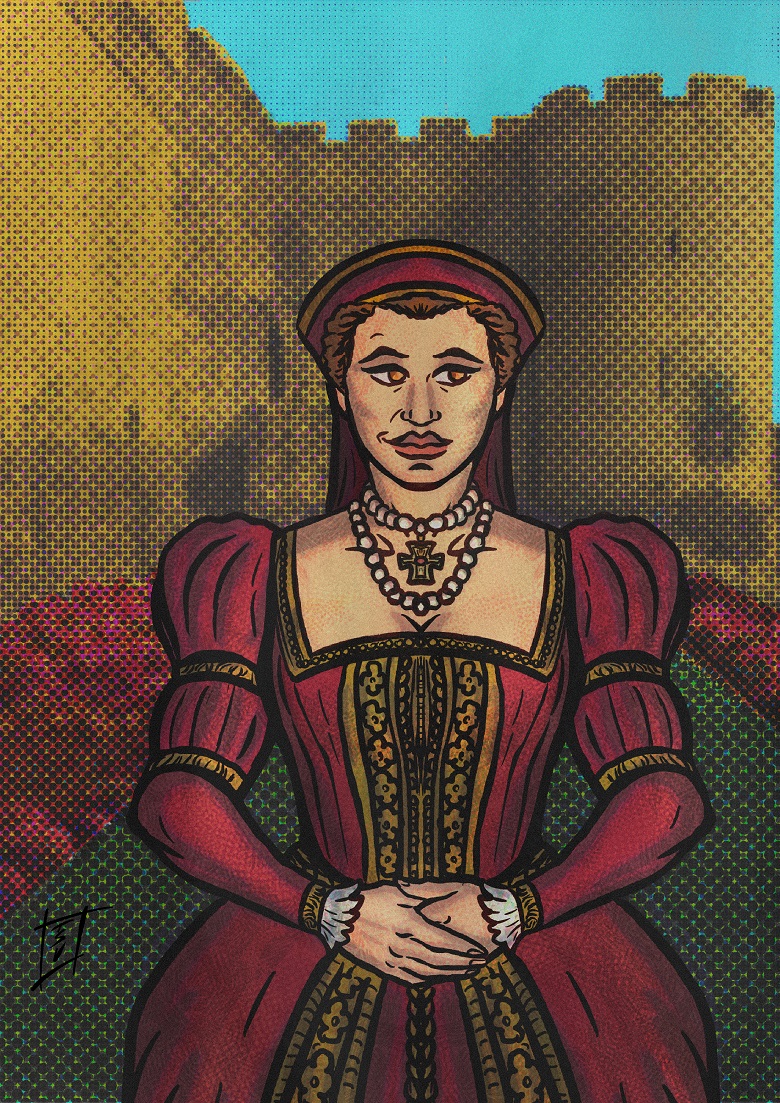
Illustration of Nichola by Thomas Secmezsoy-Urquhart
Yet, Mary’s affection for Nichola seems clear. For three years after her abdication, Nichola and her keeper, Jacqueline Critoflat, continued to receive fine clothes and financial support from Mary. In 1570, their “expensis and fraucht [travel]” were paid so they could return to France.
William Gibson – the short statured man who defied death
A final interesting disabled figure at James VI’s court was the performer and ‘dwarf’ William Gibson.
In the late 1570s, Gibson took part in a bold stage performance that accused Regent Morton of murder using satirical verses known as “infamous rhymes.” The act was considered treasonous, and most of the performers were sentenced to death.
Remarkably, Gibson was spared thanks to a show of power and independence by the young King James VI, who was only around 12 or 13 years old at the time.
Instead of punishment, Gibson was given a formal role as a jester and ‘dwarf’ in the royal household between 1579 and 1581. His survival and appointment highlight both the risks fools faced and the influence they could hold at court.
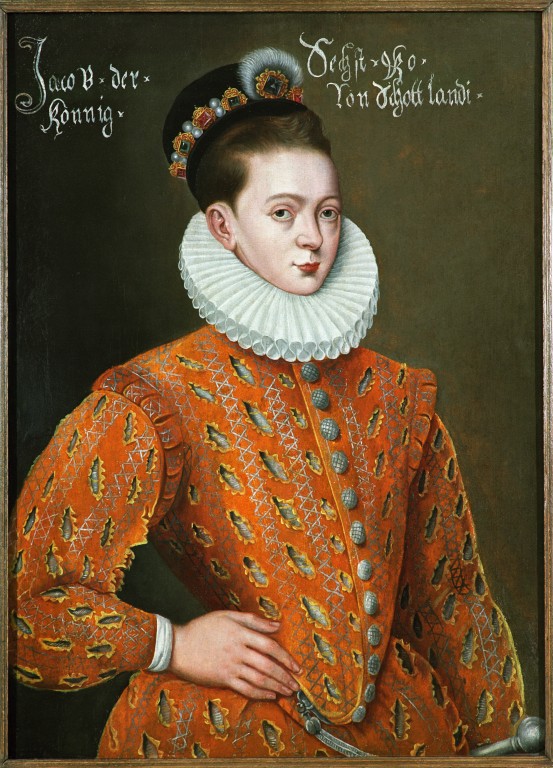
The young James VI.
Why have we ‘forgotten’ these people?
It could be argued that the fools weren’t forgotten at all, and that they were written out of history. Later, during the Enlightenment, society began to value reason and intelligence above all. Neurodivergent people were seen as abnormal, and their roles were forgotten or misunderstood.
Historians often ignored or misrepresented fools. Some even claimed that replacing natural fools with comedians was a form of cultural progress. But, in my opinion, this view is ableist. It dismisses the real contributions of disabled people in history.
Only recently, thanks to disability studies, have we started to uncover the truth. These fools weren’t just side characters; they were central to court life and culture.
Walking in their footsteps
Scottish fools have walked the many halls, gardens and courtyards of Scotland’s historic places.
We know that Curry, Bute and Cristofer all spent time at Edinburgh Castle. Serat was with her queen at St Andrews Cathedral when she married James V.
In the case of Stirling Castle, they have even left a lasting physical mark on the architecture we can now see today in the form of the fool image among the many Stirling Heads. In a room of carved round heads representing important historical, legendary, and symbolic figures, the fool was an essential inclusion.
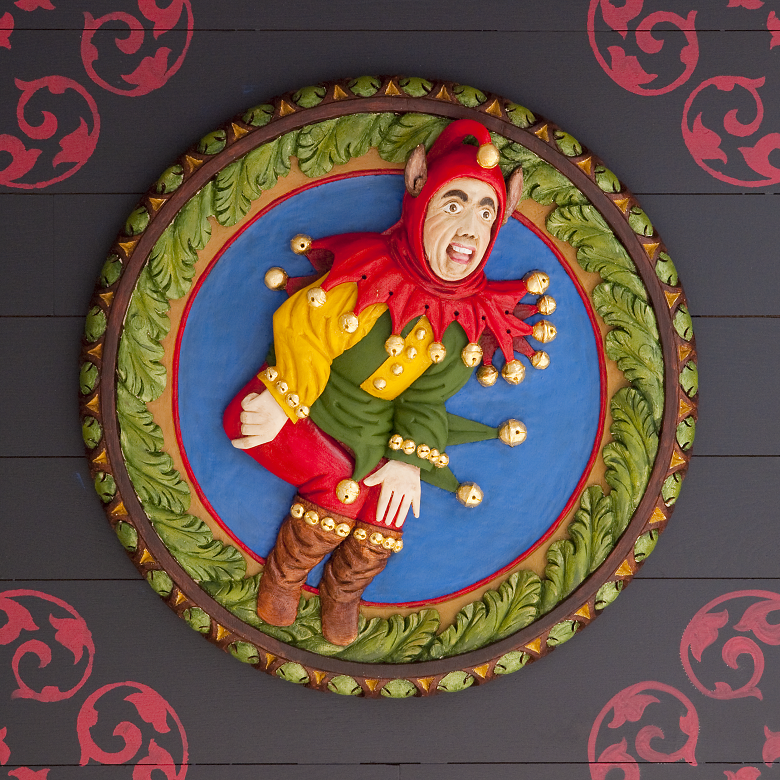
A jester depicted on one of the Stirling Heads panels at Stirling Castle.
What can we learn today?
In the past, neurodivergent people were valued for their honesty and unique perspectives. Today, many still face stigma. Many autistic people like me are extremely truthful and blunt. When we see something to be true or moral we will assert this is the case and not understand others’ inability to see what is completely clear.
Greta Thunberg is a good example. Since childhood she has refused to sugarcoat the need for immediate action against climate change and, recently, has been similarly blunt in her support of the Palestinian people. Disabled voices like Greta’s (or even mine on occasion) are often ignored because we’re disabled. But it seems as though voices of neurodivergent truth-tellers are more necessary than ever before.
Celebrating the fools
Curry, Nornee, Bute, Lowis, Serat, Nichola, Gibson. These names might not be famous, but they should be. They were disabled individuals who shaped Scottish history through laughter, truth, and companionship.
Their stories remind us that inclusion isn’t new. It’s been part of our culture for centuries. And by remembering them, we honour a legacy of neurodiversity that deserves to be celebrated, not forgotten.
Illustrator bio

Thomas Secmezsoy-Urquhart is an autistic Glasgow-based illustrator and photographer. They used to want to work on comic books and animation but as they made my their way through art school they found a new passion in portrait and fashion photography. They now find when they come back to illustration much fun in bringing in photo collaging elements as it reminds them of those segments from Monty Python.

